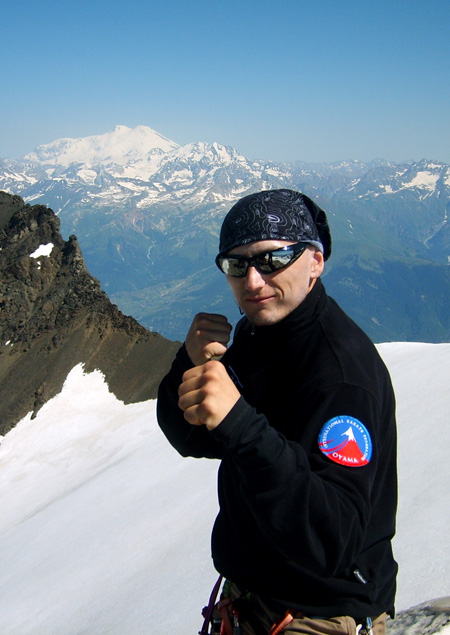|
Caucasian success On the 19th of July, 2008, Sensei Piotr Picheta from the Cracovian OYAMA Club, together with his three colleagues: Maciej Chmielecki, Damian Granowski and Tomek Mucha, reached Georgia, crossing Ukraine, Romania, Bulgaria and Turkey.
Stage I – Lajla (4008 meters above sea level) 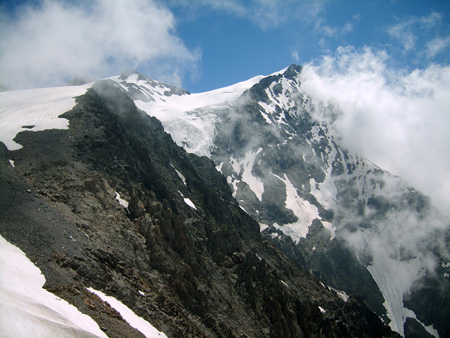 Svaneti is an alpine region of Georgia, situated in the central part of the Caucasian Mountains. It is inhabited by extraordinarily proud and hospitable Svans, whose culture has been formed in isolation from the rest of the world, due to the geographic region, which is quite difficult to reach. The highest peak of the region is Lajla (4008 meters), which was the first top of the Polish crew, also in the acclimatization sense.
Having reached Lentekhi – a small village in Southern Svaneti – the tourists were given a warm welcome by the group of grimly looking highlanders. As it later turned out, they were the local police officers, who considered taking care of Polish tourists as a matter of their honor.
After a night at the police station, the tourists were transported in UAZ about 20 kilometers along the river where they began a three-day long march, heading 25 kilometers to Lajla. On the 23rd of July, they reached an alpine pasture land (around 1700 meters) from which they began the real trip. At the beginning, the route led along a very steep slope. Sothickly was the slope overgrown with vegetation that it was almost impossible for the tourist to climb with rucksacks weighting over 35 kilos on their backs. Having spent a night at the altitude of 2500 meters, the climbers left their deposits under the rocks and much lighter, carrying only few pieces of the necessary equipment, they began to reach the peak. Unfortunately, the mountains once again proved that the trip was not to be easy one. Climbing with no safety lines not only was difficult but also slowed them down substantially. They reached the glacier much later than they had hoped to. Carrying the minimum of the equipment, with no tents or sleeping bags, they were forced to walk down to the green pastures again to carry the rest of the equipment back up to the glacier.
The choice they made was right, yet the time was difficult for them .
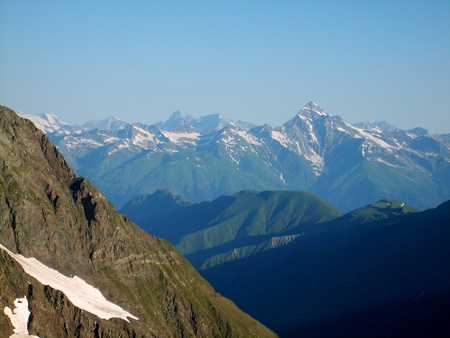 On the next day they moved on to reach the peak, to finally stand on the longed-for Lajla (4008meters). For the next couple of hours the cloudless sky allowed them to enjoy the amazing panorama of the enormous Caucasus, especially the range with the visibly marked and dangerous peaks of Elbrus, Shkhara or Ushba, also called “Witch”.
The colossus covered with snow and everlasting ice allowed them to reach the peak. It treated them with an unforgettable and impressive view. On this moment, they felt sure that one cal lose a lot, but seeing what they saw and feeling what they felt was to stay in them for ever.
Stage II – Mount Kazbek (5047 meters above the sea level) 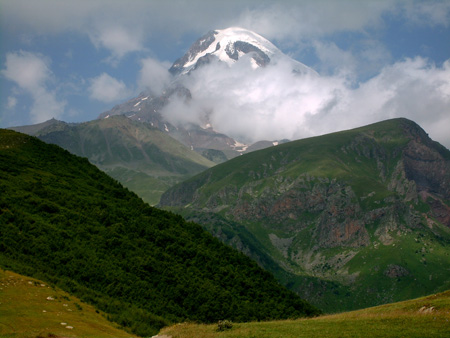 The Chevy region is situated between the two highest ranges of the Caucasus, with its northern boundaries marked with the Side Range with the enormous, yet distant Mount Elbrus. The name of the region has is connected with the relief, which is reminiscent of the alpine landscape, due to numerous ravines, (Chevy = ravine). Kazbek is stately dominating over Chevy; it is one of the highest peaks of the Caucasus. On the 3rd of August, the climbers reached the Stepancminda village, at the foot of the Mount Kazbek. Resourcefully arranged accommodation in Polish hostel (sic!) allowed them to enjoy the view of the ice pyramid of the peak, surrounded by the red shades of the setting sun.  On that day there were six teams that left to reach the peak, but only three of them managed to do so. They were Poles, among others, whose determination was so strong that they refused to give up their dream.
Stage III – Evacuation from Georgia
The 8th of August, on Piotr’s name-day, the Georgian army clashed with the Ossetian troops, supported by Russia. The situation made Poles evacuate immediately from the borderland region. On the 9th of August, they came back to Tbilisi. A day later, the road from Vladikavkaz (frontier crossing), through Stepancminda (Kazbek), to the capital was blocked. On their way, they passed battle wagons and a lot of police officers. It was, in fact, a real war. Having contacted with Polish Embassy, they were tucked into city busses and transported to the capital of Armenia – Yerevan. They spent a night at a hotel there. On the 11th of August, after a three-hour flight in the government plane, they were in Poland. They were welcomed by numerous TV stations, lights, crowd of reporters and a lot of questions. And all that our tourists wanted to do was to go home, as it was their happy-ending of the great adventure. OSU! 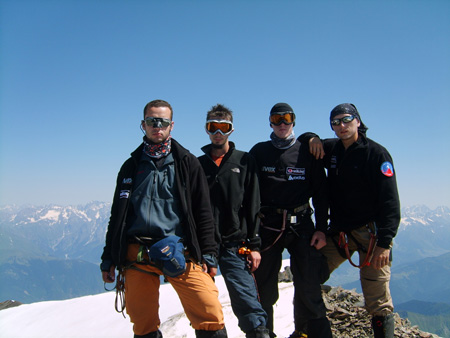 |
